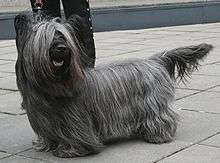Skye Terrier
 A Skye Terrier | ||||||||||||||||||||||||||
| Origin | Scotland | |||||||||||||||||||||||||
|---|---|---|---|---|---|---|---|---|---|---|---|---|---|---|---|---|---|---|---|---|---|---|---|---|---|---|
| ||||||||||||||||||||||||||
| Domestic dog (Canis lupus familiaris) | ||||||||||||||||||||||||||
The Skye Terrier is a breed of dog that is a long, low, hardy terrier and "one of the most endangered native dog breeds in the United Kingdom" according to The Kennel Club.
Appearance

Coat
The Skye is double coated, with a short, soft undercoat and a hard, straight topcoat. The shorter hair of the head veils the forehead and eyes, forming a moderate beard. The ears are generally well feathered and, in prick-eared examples, the hair normally falls like a fringe, accenting the form, and blending with the side locks.
Colour
Fawn, blue, dark or light grey, blonde, and black with black points (ears and muzzle) all occur. They may have any self colour, allowing for some shading of same colour on the body and a lighter undercoat, so long as the nose and ears are black. There is generally no further patterning on the body, but a small white spot on the chest is relatively common.
Types
Except for the shape and size of the ears, there is no significant difference nor preference given between the prick- and drop-eared types. When prick, they are medium-sized, carried high on the skull and angled slightly outwards.
Upkeep
.jpg)

The Skye Terrier is a hunting dog and enjoys a daily outing, exploring in a safe area. It also needs a short to moderate walk with its owner to stay in shape. The Skye enjoys life as a housedog, and prefers not to live outdoors. So, owners should not keep them outdoors as their natural habitats. Regular combing (about twice a week) is all that is needed to keep the Skye looking well and detangled. Many owners think that an occasional bath will soften the coat, as is often the case with other terriers, but that is not the case. An occasional bath will not soften the coat too much. Owners must pay attention to the area around their eyes and mouth, this may need frequent cleaning.[1]
Health
If a Skye is exercised too often, too young, especially before 8 months, they can damage their bone growth, leading to a painful limp and possibly badly bowed legs. Jumping up and down from objects, climbing over objects, running, even long walks, are all things to be avoided for the first 8 to 10 months to prevent later problems and allow for correct closure of the growth plate.
Degenerative disc disease is also a common problem in short-legged dogs; as many as 10% of Skyes will suffer from it.
Mammary cancer is the leading cause of Skye Terrier deaths, with hemangiosarcomas (a malignant tumour of the blood vessels), autoimmune disease, and hyperthyroidism[2] as other concerns of the breed.
History

Scotland has long been a stronghold of small plucky terriers, and the Skye Terrier is among the oldest of them. They developed along the west coastal area, where they hunted fox and otter from among the rocky cairns.
The purest of these dogs were found on the Isle of Skye, and the dogs were then named Skye Terriers. Skye Terriers were first described in the sixteenth century, when it was already noteworthy for its long coat. Some confusion exists in tracing its history because, for a certain time, several different breeds had the same name "Skye Terrier". The loyal dog, present under the petticoat of Mary, Queen of Scots at her execution, has been ascribed as a Skye Terrier. In 1840, Queen Victoria made the breed fancy, keeping both drop-(floppy) and prick-(upwards) eared dogs.
This highly increased its popularity in many of the high societies and among commoners, which are very high class. Soon enough, the Skye Terrier came to America because of its extreme popularity throughout its country and some others. The AKC recognized the breed in 1887, and it quickly rose to the show scene position. Even though this was a strong start and the breed's great appearance, its popularity has dropped. Now it is among one of the least known terriers. Many people are unaware of this breed's old popularity because it is not famous now.[3]
Under threat
There are concerns that the breed is under threat of extinction with only 30 born in the UK in 2005.[4] It is today the most endangered of the Vulnerable Native Breeds of that country, and within 40 years the breed may disappear completely.[5]
See also
References
- ↑ Coile, Caroline (2005). "The Terrier Group". Encyclopedia of Dog Breeds (second edition) (2 ed.). p. 350. ISBN 0-7641-5700-0.
- ↑ Disorders by breed, Skye Terrier, University of Sydney, retrieved 24 September 2014
- ↑ Coile, Caroline (2005). "The Terrier Group". Encyclopedia of Dog Breeds (second edition) (2 ed.). p. 352. ISBN 0-7641-5700-0.
- ↑ Savill, Richard (5 July 2006), "Skye Seven raise hope for breed's survival", Daily Telegraph
- ↑ Elliott, Valerie (12 June 2006), "Fight is on to save dogs that fell out of fashion", The Times
External links
- Skye Terrier at DMOZ